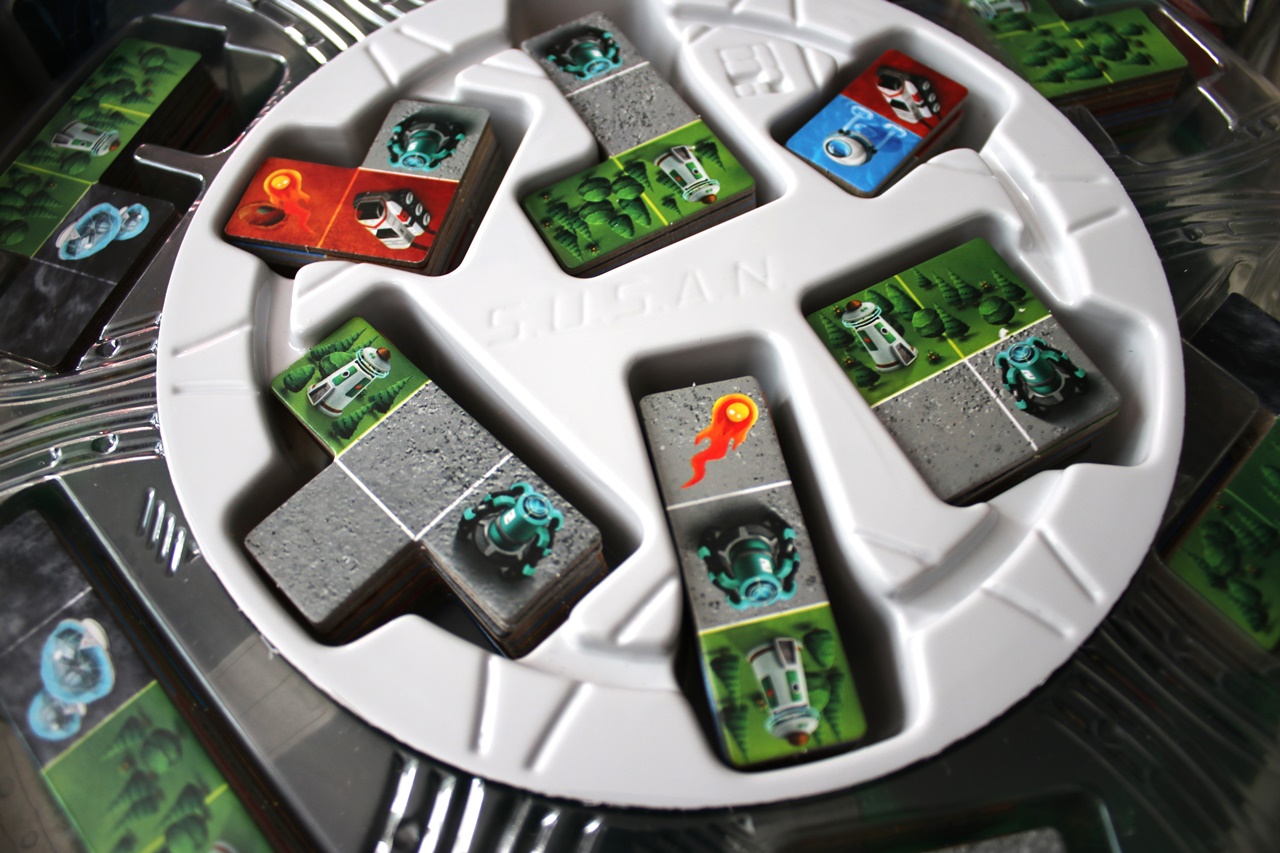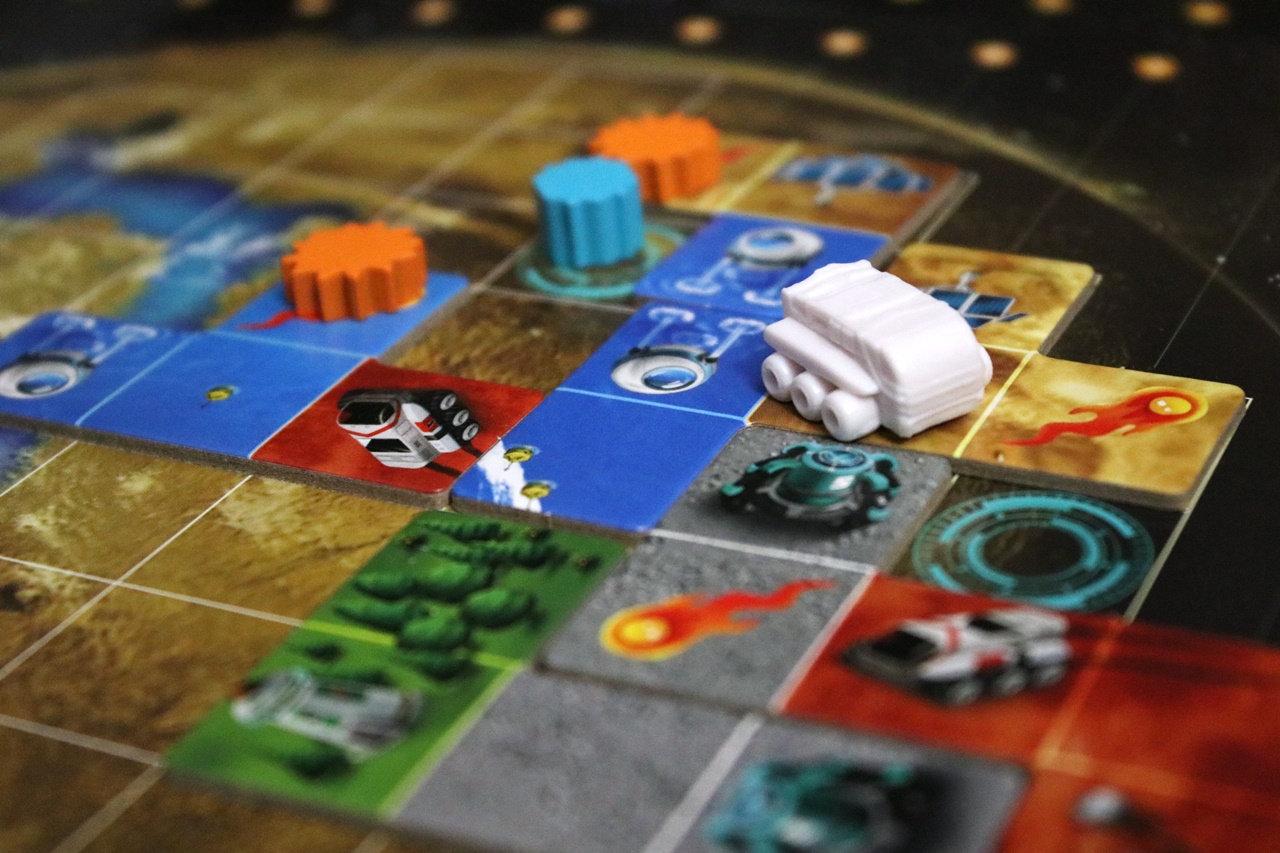Appearances can be deceiving. And although I have a lot of experience in board games, there are still surprises and large discrepancies between what I expect to get in the box and what is actually in it. Unexplored Planet from Portal Games is my latest surprise of this type. Both the title and the cover convinced me, because I love all space games. However, based on the publishing house and graphics, I expected a complicated board game for intermediate players. Imagine my surprise when it turned out that this is a title that can also be successfully prepared by families and less experienced people. They may not be able to plan the creation of their planet right away, but they will definitely master the rules and be able to enjoy the game.
With a great space station acting as a feeder, all terrain tiles are sorted at once and generally do not move around the box. You could try a cover, but it’s not bad without it. The remaining components, i.e. cards, resource markers, storage indicators, rovers, escape pods, meteorites, biomass clusters, scoring notebook, planet and corporation boards, and the commander marker, have their place around the dispenser, which takes up a large part of the box.

Preparations for flight
Before starting the game, everyone takes one planet and a corporation. On the first board, we place the escape pods in the marked areas, and on the second board, we place resource markers on the starting fields. Everyone receives two triangular magazine indicators in the color of their choice. One goes on the corporation’s board, and the other next to the space station next to one of the warehouses. It’s best to look at the station as a pizza divided into six slices (warehouses). Each has two types of terrain – a small one near the center and a large one near the edge. Like in classic Tetristhey have different shapes. They include symbols of a rover, civilization, water, biomass and technology, the construction of which increases the level on the appropriate track, as well as a meteorite icon on which an appropriate marker must be placed. However, all this happens only after the tile has been placed on the planet.
The first player with a commander marker can rotate the space station at will. Then everyone takes one of the two available tiles from the storage room next to their indicator. The collected areas are placed on the boards. Everyone moves their resource markers, the symbols of which are located on the newly placed tile, and adds meteorites if the appropriate icon appears on the planet.
It would seem that the central part of the game is the planet, but equally important, or perhaps more important, is the corporation board. The higher the level we achieve on individual tracks, the more points we will earn at the end, but before that we can collect many other actions. After moving the marker to a new field, we do what we covered. This may be downloading a new rover or moving one already on the board, increasing the level of a bonus on any track, obtaining a biomass pool or selecting a civilization card.

The game ends when one of the players cannot place a tile on their planet or one of the warehouses is empty. The final score consists of points from completely filled rows and columns on the planet (excluding those with meteorites), medals achieved on the corporation board tracks, meteorites and escape pods collected from the planet, and points from civilization and objective cards.
Houston, we have a problem, but only one
If the ship that would take us to the new planet was as solid as planchettes, we would have a serious problem. Portal Games publishes good and solidly made board games, so I’m surprised how thin they are and therefore susceptible to destruction. I have nothing to complain about the rest of the components. The graphics fit the theme and the symbols are understandable.
Although I’m not a fan of Patchwork , which is the first thing that comes to mind when I think of Tetris in board games, in The Uncharted Planetthis part of the mechanics works very nicely. When laying tiles, we must take several issues into account, which gives us a chance for pleasant thinking. Of course, we want to fill in all the fields because there are points for rows and columns. However, we initially have to avoid the escape pods because we want to collect them with the rover that we don’t have yet, rather than destroy them by placing a tile on them. Then we may be left with single holes in which we can only arrange biomass communities. We also collect meteorites with our space vehicles, so when placing them we want to place their markers as close to the rovers as possible so that they don’t have to travel far. In addition, there are tiles with an energy symbol. There is no separate development track, but it allows you to increase your level on the icon track,

There is just as much fiddling on the corporate board. We want to raise the level of civilization to obtain cards that give additional points or facilities. The biomass gives us tiles with which to patch holes in the planet, and the rover track allows us to move vehicles to collect meteorites and escape pods. Everything is important, but you can’t achieve the maximum on every track.
Uncharted Planet is a very successful board game. The only downside is the very thin boards, which I will have to laminate. Replayability is high, and it is even more enhanced by additional, asymmetric planets. The level of combination is satisfactory for me. Game time is also a plus. We make most of the moves at the same time, so even with a full team, the game doesn’t take long. Alternatively, the second minus, but for me insignificant, may be the lack of interaction. Everyone is focused on their planet and tracks. In a two-player game, you sometimes look at your opponent and rotate the space station so as not to give you a better-fitting tile to choose from. But in a larger group it is impossible to harm everyone at the same time, unless by accident.

Even though I expected a more difficult game, I really liked Uncharted Planet . It will definitely stay in my collection and I will gladly come back to it. It should reach a wide audience, because less experienced people will easily understand its rules, and experienced players will find enough pleasure in solving the Tetris planet.

